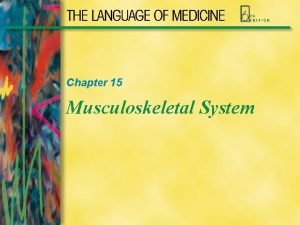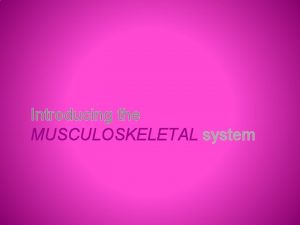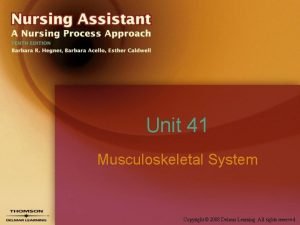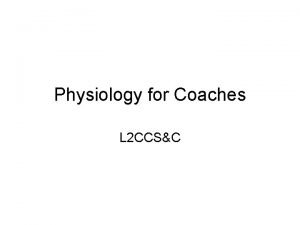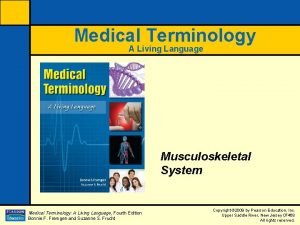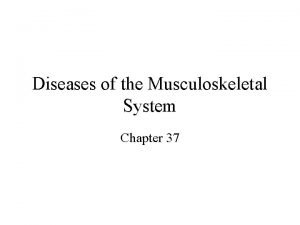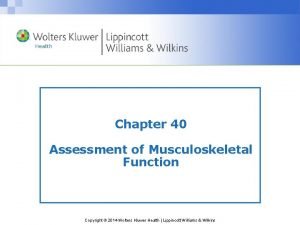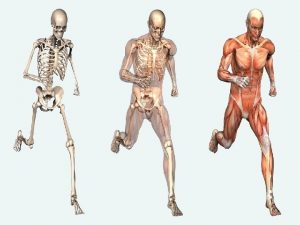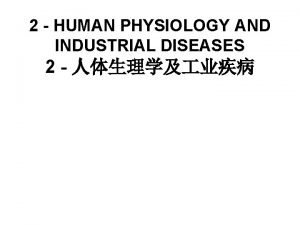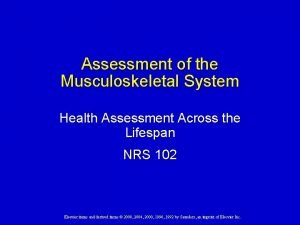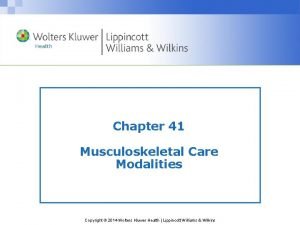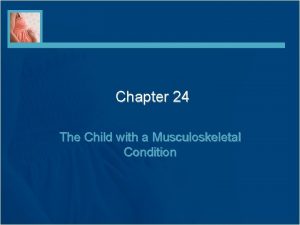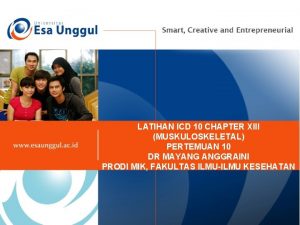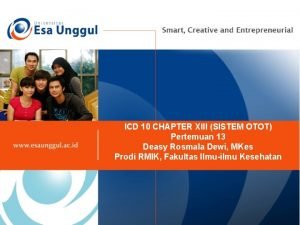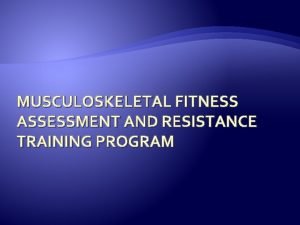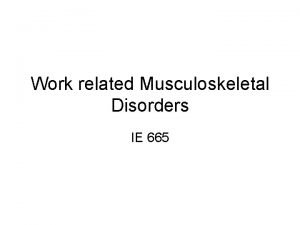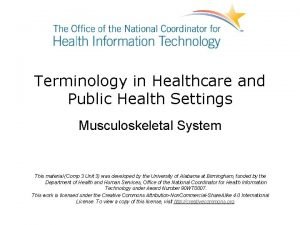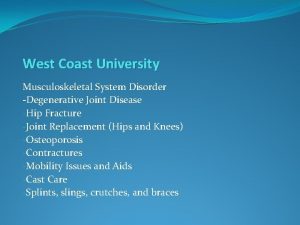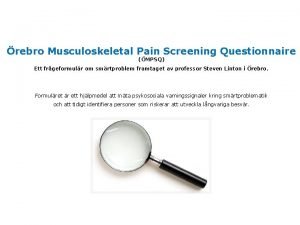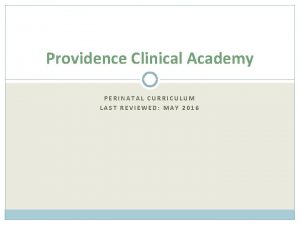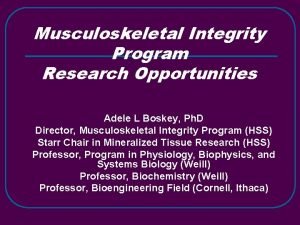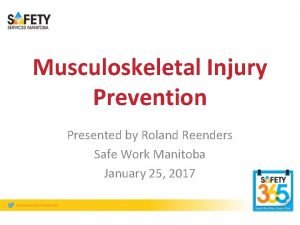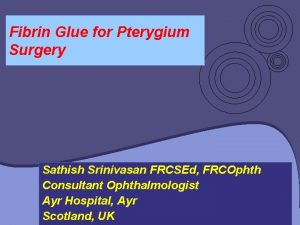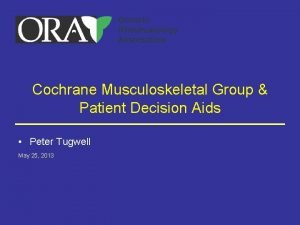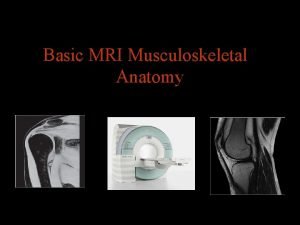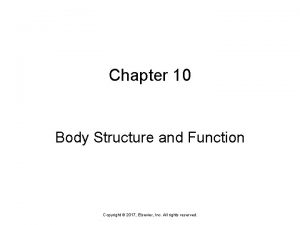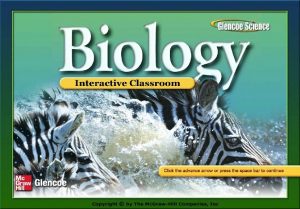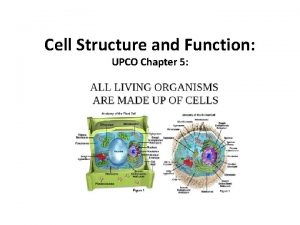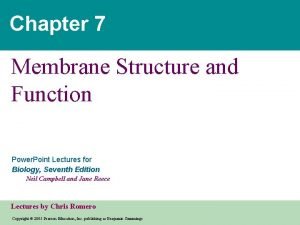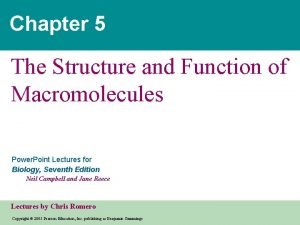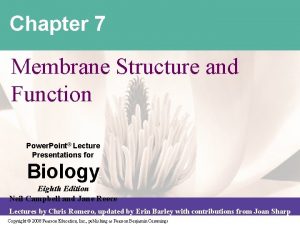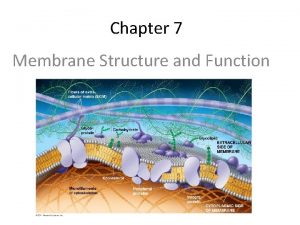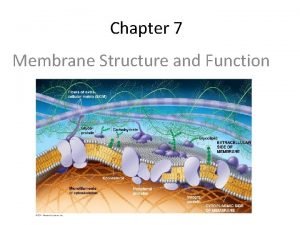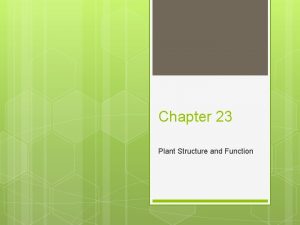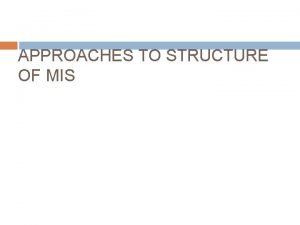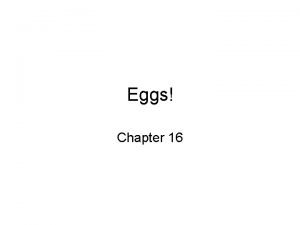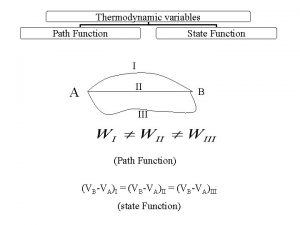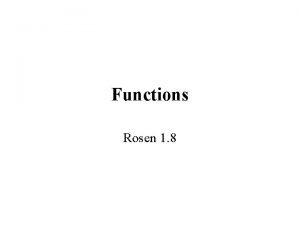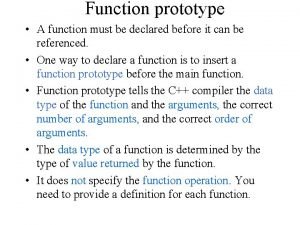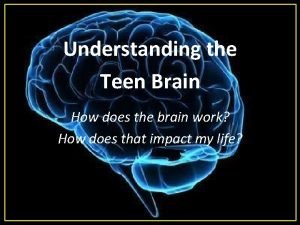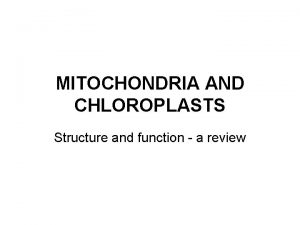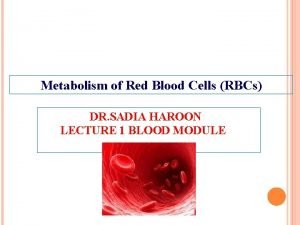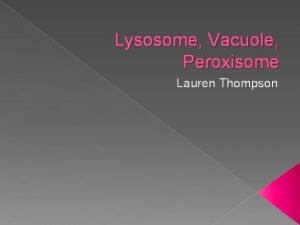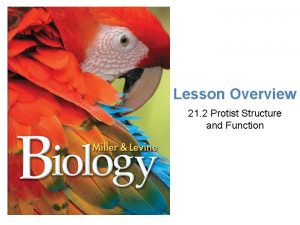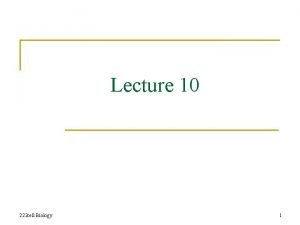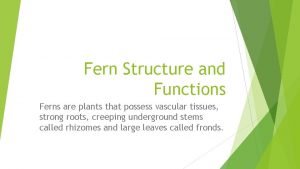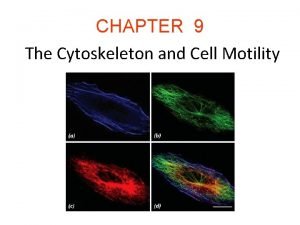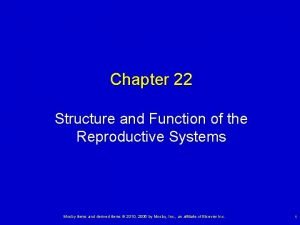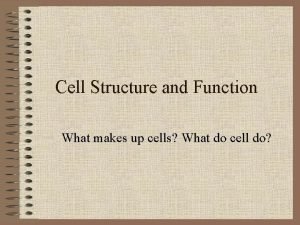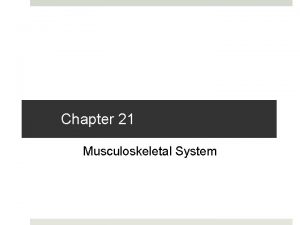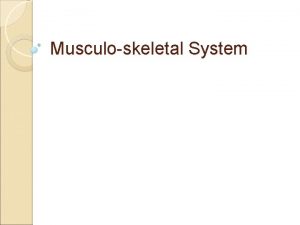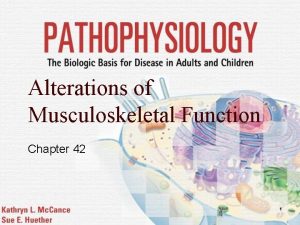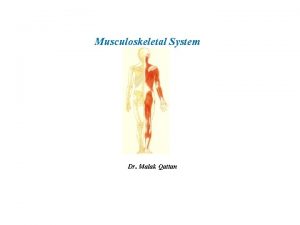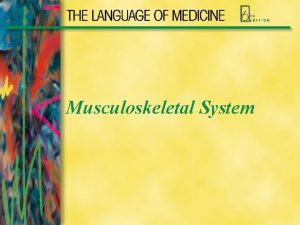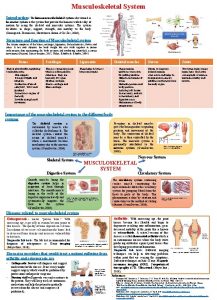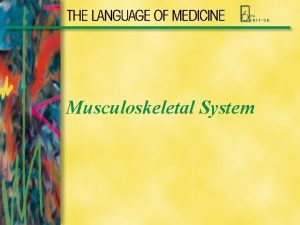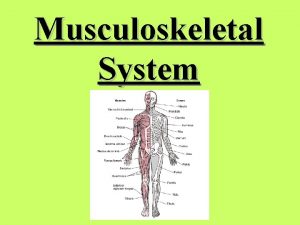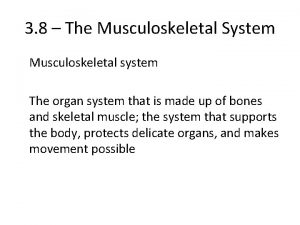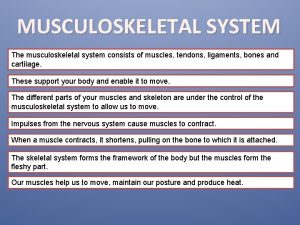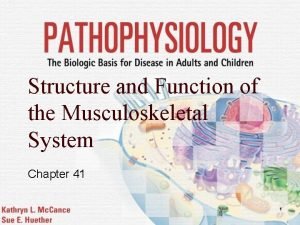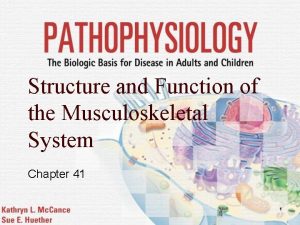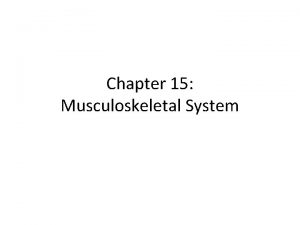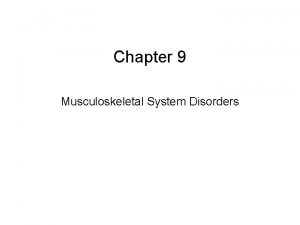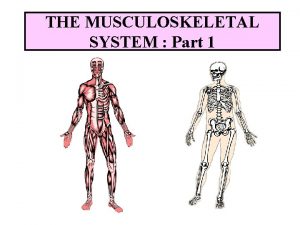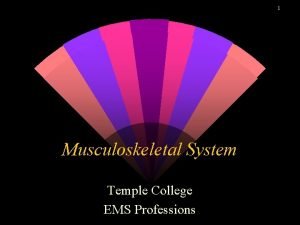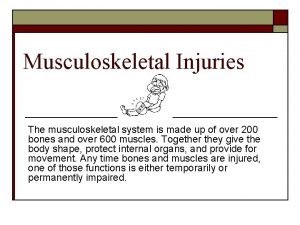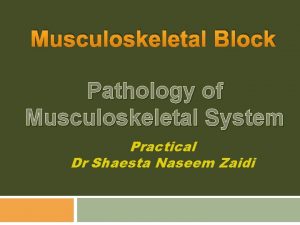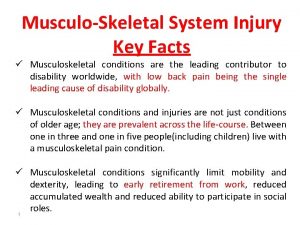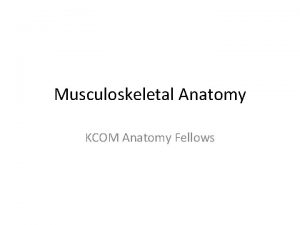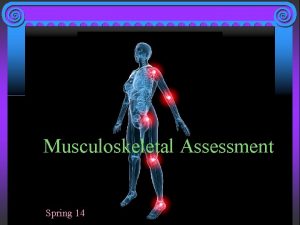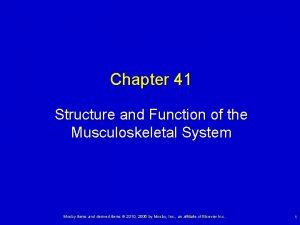Musculoskeletal System Chapter 21 Structure and Function Components



























































- Slides: 59

Musculoskeletal System Chapter 21

Structure and Function Components of musculoskeletal system Skeleton is bony framework of body 206 bones support body like posts and beams of building Bone and cartilage are specialized forms of connective tissue Bone is hard, rigid, and very dense Cells are continually turning over and remodeling Joints, or articulations, are places of union of two or more bones Joints are functional units of musculoskeletal system permitting mobility needed for activities of daily living

Structure and Function Components of musculoskeletal system Connective Tissue Joints Cartilage Fibrous (synarthrotic) Ligaments Cartilaginous Tendons Amphiarthrotic Fascia Synovial Diarthrotic

Structure and Function Nonsynovial joints: bones united by fibrous tissue or cartilage Immovable- sutures in skull Slightly movable- vertebrae

Structure and Function Synovial joints Move freely because bones separated and enclosed in joint cavity Cavity filled with lubricant, or synovial fluid; synovial fluid allows sliding which permits movement Layer of resilient cartilage covers surface of opposing bones; receives nourishment from synovial fluid Cartilage cushions bones and gives smooth surface to facilitate movement Has tough, firm consistency, yet is flexible

Structure and Function Synovial joints Joint surrounded by fibrous capsule and supported by ligaments Ligaments are fibrous bands running directly from one bone to another; strengthen joint and help prevent movement in undesirable directions Bursa: enclosed sac filled with synovial fluid Help muscles and tendons glide smoothly over bone Located in areas of potential friction, e. g. , subacromial bursa of shoulder, pre-patellar bursa of knee

Synovial Joint

Structure and Function Muscles account for 40% to 50% of body’s weight When they contract, they produce movement Muscles are of three types: skeletal, smooth, and cardiac Skeletal or voluntary muscles are under conscious control Each skeletal muscle is composed of bundles of muscle fibers, or fasciculi Skeletal muscle attached to bone by tendon, a strong fibrous cord

Structure and Function Muscles Skeletal muscles produce following movements: Flexion: bending limb at joint Extension: straightening limb at joint Abduction : moving limb away from midline of body Adduction : moving limb toward midline of body Pronation: turning forearm so that palm is down Supination: turning forearm so that palm is up Circumduction: moving arm in circle around shoulder

Structure and Function Muscles Skeletal muscles produce following movements: Inversion: moving sole of foot inward at ankle Eversion: moving sole of foot outward at ankle Rotation: moving head around central axis Protraction: moving body part forward, parallel to ground Retraction: moving body part backward, parallel to ground Elevation: raising a body part Depression: lowering a body part

Skeletal Muscle Movements

Structure and Function Temporomandibular joint (TMJ) Articulation of mandible and temporal bone Can feel it in depression anterior to tragus of ear TMJ permits jaw function of speaking and chewing Allows three motions: Hinge action to open and close jaws Gliding action for protrusion and retraction Gliding for side-to-side movement of lower jaw

Structure and Function Spine Vertebrae are 33 connecting bones stacked in vertical column Can feel spinous processes in furrow down midline of back Vertebrae in humans 7 cervical 12 thoracic 5 lumbar 5 sacral 3 to 4 coccygeal

Structure and Function Spine Surface landmarks orient you to their levels: Spinous processes of C-7 and T-1 prominent at base of neck Inferior angle of scapula normally at level of inter-space between T-7 and T-8 Imaginary line connecting highest point on each iliac crest crosses L-4 Imaginary line joining two symmetric dimples that overlie posterior superior iliac spines crosses sacrum

Surface Landmarks of Spine

Structure and Function Spine Lateral view shows vertebral column has four curves, a double-S shape Cervical and lumbar curves are concave (inward or anterior) Thoracic and sacro-coccygeal curves are convex Balanced or compensatory nature of curves, together with intervertebral disks, allow spine to absorb shock Intervertebral disks are elastic fibro-cartilaginous plates that constitute one fourth the length of column

Structure and Function Spine Each disk center has nucleus pulposus, made of soft, semifluid, mucoid material Disks cushion spine like shock absorber and help it move As spine moves, elasticity of disks allows compression on one side, with compensatory expansion on other Motions of vertebral column are flexion (bending forward), extension (bending back), abduction (to either side), and rotation

Structure and Function Shoulder Gleno-humeral joint: articulation of humerus with glenoid fossa of scapula Ball-and-socket action allows mobility of arm on many axes Rotator cuff: group of four muscles and tendons support and stabilize shoulder Palpable landmarks to guide your examination Scapula and clavicle form shoulder girdle Can feel the bump of the scapula’s acromion process at very top of shoulder

Shoulder

Structure and Function Elbow joint contains three bony articulations: humerus, radius, and ulna of forearm Hinge action moves forearm (radius and ulna) on one plane, allowing flexion and extension Palpable landmarks are medial and lateral epicondyles of humerus and large olecranon process of ulna between them Radius and ulna articulate with each other at two radio-ulnar joints, one at elbow and one at wrist Permit pronation and supination of hand forearm

Structure and Function Wrist and carpals Wrist, or radio-carpal joint: articulation of radius on thumb side and row of carpal bones Condyloid action permits movement in two planes at right angles: flexion and extension, and side-to-side deviation Mid-carpal joint: articulation allows flexion, extension, and some rotation Meta-carpophalangeal and inter-phalangeal joints permit finger flexion and extension Flexor tendons of wrist and hand enclosed in synovial sheaths

Bones of Hand

Structure and Function Hip: articulation between acetabulum and head of the femur Ball-and-socket action permits wide range of motion on many axes Less range of motion (ROM) than shoulder, but more stability for weight-bearing function Hip stability is due to powerful muscles that spread over joint, strong fibrous articular capsule, and deep insertion of head of femur Three bursae facilitate movement

Structure and Function Hip Palpation of bony landmarks will guide examination: Can feel entire iliac crest, from anterior superior iliac spine to posterior Ischial tuberosity lies under gluteus maximus muscle and palpable when hip flexed Greater trochanter of femur below iliac crest and between anterior superior iliac spine and ischial tuberosity Felt best when person standing in flat depression on upper lateral side of thigh

Structure and Function Knee joint: articulation of three bones—the femur, tibia, and patella (kneecap)—in common articular cavity Largest joint in body; hinge joint, permitting flexion and extension of lower leg on single plane Synovial membrane is largest in body; forms sac at superior border of patella, supra-patellar pouch Two wedge-shaped cartilages, called medial and lateral menisci, cushion tibia and femur

Structure and Function Knee stabilized by two sets of ligaments: Cruciate give anterior and posterior stability and help control rotation Collateral ligaments give medial and lateral stability and prevent dislocation Landmarks of knee joint include: Quadriceps muscle, felt on anterior and lateral thigh Muscle’s heads merge into common tendon to enclose round bony patella; then inserts down tibial tuberosity and felt as bony prominence in midline

Structure and Function Knee Landmarks of knee joint include: Note lateral and medial condyles of tibia Medial and lateral epicondyles of femur are on either side of patella

Landmarks of Knee

Structure and Function Ankle and foot Ankle or tibiotalar joint: articulation of tibia, fibula, and talus Hinge joint, limited to flexion (dorsiflexion) and extension (plantar flexion) in one plane Landmarks are two bony prominences on either side Medial malleolus and the lateral malleolus Strong, tight medial and lateral ligaments extend from each malleolus onto foot to help lateral stability of ankle May be torn in eversion or inversion sprains of ankle

Structure and Function Ankle and foot Joints distal to ankle give additional mobility to foot: Sub-talar joint permits inversion and eversion of foot Foot has longitudinal arch, with weight-bearing distributed between parts that touch ground, the heads of metatarsals and calcaneous (heel)

Ankle and Foot

Structure and Function Developmental competence Infants and children By 3 months fetus has formed skeleton of cartilage Bone growth continues rapidly during infancy and steadily in childhood, until adolescent growth spurt Increase in width or diameter is by deposition of new bony tissue around shafts Lengthening occurs at epiphyses, or growth plates Any trauma or infection at these locations puts growing child at risk for bone deformity

Structure and Function Developmental competence Aging adult Bone remodeling is cyclic process of resorption and deposition; after age 40 resorption occurs more rapidly than deposition Net effect is loss of bone density, or osteoporosis Postural changes are evident with aging, and decreased height is most noticeable Shortening of vertebral column caused by loss of water content and thinning of intervertebral disks Decreases in height of individual vertebrae, which occurs in later years from osteoporosis

Structure and Function Developmental competence Aging adult Other postural changes are kyphosis, backward head tilt to compensate for kyphosis, and slight flexion of hips and knees Distribution of subcutaneous fat changes through life; contour different, even if weight is same as when younger Begin to lose fat in face and deposit it in abdomen and hips

Structure and Function Developmental competence Aging adult In 80 s and 90 s, fat further decreases in periphery, especially noticeable in forearms and apparent over abdomen and hips Loss of subcutaneous fat leaves bony prominences more marked Absolute loss in muscle mass occurs; some decrease in size, and some atrophy, producing weakness

Structure and Function Developmental competence Aging adult Contour of muscles becomes more prominent, and muscles and tendons feel more distinct Lifestyle affects musculoskeletal changes Sedentary lifestyle hastens musculoskeletal changes of aging Physical exercise increases skeletal mass and helps prevent or delay osteoporosis Physical activity delays or prevents bone loss in postmenopausal and older women

Subjective Data: Health History Questions Functional assessment of Activities of Daily Living(ADL) Do joint (muscle, bone) problems create any limits on your usual ADLs? Which ones? Bathing: Do you have trouble getting in and out of tub or using faucets? Toileting: Do you have trouble urinating or moving bowels? Are you able to get on and off toilet and to wipe yourself? Dressing: Can you do buttons, zippers, fastening behind neck, pulling dress or sweater over head, pulling up pants, tying shoes, and can you get shoes that fit?

Subjective Data: Health History Questions Functional assessment of ADLs Grooming: Can you shave, brush teeth, brush or fix hair, and apply makeup? Eating: Can you prepare meals, pour liquids, cut up foods, bring food to mouth, and drink? Mobility: Can you walk, walk up or down stairs, get in and out of bed, get out of house? Communicating: Can you talk, use the telephone, and write?

Subjective Data: Health History Questions Self-care behaviors Are there any occupational hazards that could affect muscles and joints? Do they involve heavy lifting? Are there any repetitive motions or chronic stress to joints? Have you made any efforts to alleviate these? Tell me about your exercise program: describe type of exercise, frequency, warm-up program Do you have any pain during exercise? How do you treat it? Have you had any recent weight gain? Please describe your usual daily diet.

Subjective Data: Health History Questions Self-care behaviors Are you taking any medications such as aspirin, anti-inflammatories, muscle relaxants, or pain relievers? If person has chronic disability or crippling illness: How has your illness affected: Interaction with your family? Interaction with your friends? The way you view yourself?

Subjective Data: Health History Questions Additional history for aging adult Use functional assessment history questions to elicit any loss of function, self-care deficit, or safety risk Have you had any change in weakness over past months? Have you had any increase in falls or stumbling in past months? Do you use any mobility aids to help you get around such as a cane or walker?

Objective Data: Physical Examination Preparation Complete musculoskeletal exam is appropriate for persons with articular disease, history of musculoskeletal symptoms, or any problems with Activities of Daily Living ADLs Make person comfortable before and throughout exam; drape for full visualization of body part you are examining without needlessly exposing person Take an orderly approach: head to toe, proximal to distal, and from midline outward

Objective Data: Physical Examination Preparation Support each joint at rest; muscles must be soft and relaxed to assess joints accurately Take care when examining any inflamed area where rough manipulation could cause pain and muscle spasm To avoid this, use firm support, gentle movement, and gentle return to relaxed state Compare corresponding paired joints; expect symmetry of structure and function and normal parameters for each joint

Objective Data: Physical Examination Order of examination Inspection Note size and contour of joint; inspect skin and tissues over joints for color, swelling, and any masses or deformity Presence of swelling signals joint irritation Palpation Palpate each joint, including skin for temperature, muscles, bony articulations, and area of joint capsule; notice any heat, tenderness, swelling, or masses which signal inflammation

Objective Data: Physical Examination Order of examination Palpation Joints normally not tender to palpation If tenderness occurs, localize to specific anatomic structures, e. g. , skin, muscles, bursae, ligaments, tendons, fat pads, or joint capsule Range of Motion (ROM) Ask for active voluntary ROM while stabilizing the body area proximal to that being moved Familiarize yourself with the type of each joint and its normal ROM so that you can recognize limitations

Objective Data: Physical Examination Range Of Motion(ROM) For limitations, gently attempt passive motion; anchor joint with one hand while other hand slowly moves it to its limit; normal ranges of active and passive motion should be same Limitation in ROM is most sensitive sign of joint disease Joint motion normally causes no tenderness, pain, or crepitation Do not confuse crepitation with normal discrete “crack” heard as tendon or ligament slips over bone during motion

Objective Data: Physical Examination Order of examination Muscle Testing Test strength of prime mover muscle groups for each joint; repeat motions for active ROM Ask person to flex and hold as you apply opposing force Muscle strength should be equal bilaterally and should fully resist opposing force

Objective Data: Physical Examination Wrist and hand Phalen test Ask person to hold both hands back to back while flexing wrists 90 degrees Acute flexion of wrist for 60 seconds produces no symptoms in the normal hand Test reproduces numbness and burning in person with carpal tunnel syndrome

Objective Data: Physical Exam Wrist and hand Tinel Sign Direct percussion of location of median nerve at wrist produces no symptoms in normal hand Percussion of median nerve produces burning and tingling along its distribution, which is a positive Tinel sign for carpal tunnel syndrome

Objective Data: Physical Examination Knee Bulge Sign For swelling in supra-patellar pouch, bulge sign confirms presence of fluid as you try to move fluid from one side of joint to other Firmly stroke up on medial aspect of knee two or three times to displace any fluid; tap lateral aspect and watch medial side in hollow for distinct bulge from a fluid wave; normally, none is present

Objective Data: Physical Examination Knee Ballottement of patella Test reliable when larger amounts of fluid present Use left hand to compress supra-patellar pouch to move any fluid into knee joint With right hand, push patella sharply against femur; if no fluid is present, patella is already snug against femur Palpate infra-patellar fat pad and patella; check for crepitus by holding hand on patella as knee is flexed and extended; some crepitus in knee is not uncommon

Objective Data: Physical Examination Knee Special test for meniscal tears: Mc. Murray’s test Perform test when person has history of trauma followed by locking, giving way, or local pain in knee Position person supine as you stand on affected side Hold heel and flex knee and hip; place your other hand on knee with fingers on medial side Rotate leg in and out to loosen joint Externally rotate leg and push a valgus (inward) stress on knee; then slowly extend knee; normally leg extends smoothly with no pain

Objective Data: Physical Examination Spine Straight leg raising or Lasègue's test These maneuvers reproduce back and leg pain and may confirm presence of herniated nucleus pulposus Straight leg raising while keeping the knee extended normally produces no pain Raise affected leg just short of point where it produces pain; then dorsi-flex foot Test positive if it reproduces sciatic pain; if lifting affected leg reproduces sciatic pain, it confirms presence of herniated nucleus pulposus Raise unaffected leg leaving other leg flat; inquire about involved side

Sample Charting

Abnormal Findings Abnormalities affecting multiple joints Inflammatory conditions Rheumatoid arthritis Ankylosing spondylitis Degenerative conditions Osteoarthritis (degenerative joint disease) Osteoporosis

Abnormal Findings Atrophy Dislocated shoulder Joint effusion Rotator cuff tear Ganglion cyst Carpal tunnel syndrome

Abnormal Findings Degenerative joint disease or osteoarthritis Acute rheumatoid arthritis Syndactyly Polydactyly Epicondylitis Herniated Nucleus Pulposus Scoliosis

Abnormal Findings Abnormalities Swelling of menisci Chronic/acute gout Hallux vagus with bunion and hammer toes Callus Plantar wart Ingrown toenail Ulnar Deviation Heberden and Bouchard Nodes

Abnormal Findings Common congenital or pediatric abnormalities Congenital dislocated hip Talipes equinovarus (clubfoot) Spina bifida
 Chapter 6 musculoskeletal system diseases and disorders
Chapter 6 musculoskeletal system diseases and disorders Chapter 21 the musculoskeletal system
Chapter 21 the musculoskeletal system Chapter 15 musculoskeletal system
Chapter 15 musculoskeletal system Musculoskeletal system
Musculoskeletal system Unit 41 musculoskeletal system
Unit 41 musculoskeletal system Musculoskeletal system
Musculoskeletal system Musculoskeletal system medical terminology
Musculoskeletal system medical terminology Diseases of the musculoskeletal system
Diseases of the musculoskeletal system Assessment of the musculoskeletal system
Assessment of the musculoskeletal system Assessment of the musculoskeletal system
Assessment of the musculoskeletal system Musculoskeletal system
Musculoskeletal system Objective data for musculoskeletal system
Objective data for musculoskeletal system Chapter 40 musculoskeletal care modalities
Chapter 40 musculoskeletal care modalities Chapter 24 the child with a musculoskeletal condition
Chapter 24 the child with a musculoskeletal condition Icd 10 code for musculoskeletal spasm
Icd 10 code for musculoskeletal spasm Kode icd 10 fraktur coccygeus
Kode icd 10 fraktur coccygeus Musculoskeletal fitness test
Musculoskeletal fitness test Work related musculoskeletal disorders definition
Work related musculoskeletal disorders definition Musculoskeletal pronounce
Musculoskeletal pronounce West coast musculoskeletal
West coast musculoskeletal Musculoskeletal chest pain
Musculoskeletal chest pain Cephalohematoma
Cephalohematoma Musculoskeletal integrity
Musculoskeletal integrity Musculoskeletal injury
Musculoskeletal injury Musculoskeletal
Musculoskeletal Musculoskeletal
Musculoskeletal Sathish srinivasan
Sathish srinivasan Cochrane musculoskeletal group
Cochrane musculoskeletal group Mri
Mri Chapter 10 body structure and function
Chapter 10 body structure and function Eukaryotic cell structure
Eukaryotic cell structure Chapter 22 plant structure and function answer key
Chapter 22 plant structure and function answer key Chapter 7 cell structure and function section review 7-2
Chapter 7 cell structure and function section review 7-2 Chapter 5 cell structure and function
Chapter 5 cell structure and function Chapter 7 membrane structure and function
Chapter 7 membrane structure and function Chapter 5 the structure and function of macromolecules
Chapter 5 the structure and function of macromolecules Chapter 21 plant structure and function
Chapter 21 plant structure and function Chapter 7 membrane structure and function
Chapter 7 membrane structure and function Cell membrane polar head
Cell membrane polar head Chapter 7 membrane structure and function
Chapter 7 membrane structure and function Chapter 23 plant structure and function
Chapter 23 plant structure and function Mis subsystems
Mis subsystems Draw the structure of an egg and label it
Draw the structure of an egg and label it Function of community in pakistan
Function of community in pakistan Open closed and isolated systems
Open closed and isolated systems Digestive respiratory and circulatory system
Digestive respiratory and circulatory system State vs path function
State vs path function What is not a one to one function
What is not a one to one function What is function prototype
What is function prototype Brain structure and function
Brain structure and function What are the three parts of seed
What are the three parts of seed Chloroplast and mitochondria similarities
Chloroplast and mitochondria similarities Glutathione structure and function
Glutathione structure and function Function of vacuole
Function of vacuole Protist structure
Protist structure Primary and secondary lysosomes
Primary and secondary lysosomes Fern structures
Fern structures Structure and function of cytoskeleton
Structure and function of cytoskeleton Breast structure and function
Breast structure and function Cilia function
Cilia function


